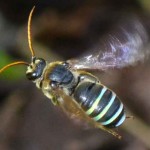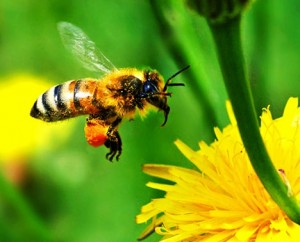 The alkali bee is an unusual ground-nesting sweat bee native to arid regions of the western United States. The alkali bee prefers to nest in bare soil where water leaches from below to the surface, the soil is moist but not wet and is dry on top. This occurs naturally in areas where a layer of hard-pan exists in alkali soils. The alkali salts form a crust sealing the top of the soil and holding in the moisture.
The alkali bee is an unusual ground-nesting sweat bee native to arid regions of the western United States. The alkali bee prefers to nest in bare soil where water leaches from below to the surface, the soil is moist but not wet and is dry on top. This occurs naturally in areas where a layer of hard-pan exists in alkali soils. The alkali salts form a crust sealing the top of the soil and holding in the moisture.
The alkali bee is slightly smaller than a honey bee and has yellow or green irridescent bands on its abdomen. The female has a stinger but rarely uses it and no protective clothing is needed to handle these bees. The female carries pollen on her back legs to her nest which she has dug in the soil. Most nest cells are between 4 and 8 inches below the surface. The pollen is moulded along with nectar into a ball, then the female lays an egg on the ball and seals the cell. The egg hatches and the larva feeds on the pollen and nectar ball until it reaches the mature larval stage. It overwinters in this stage and then pupates and emerges as an adult in the spring. There is usually a single generation each year, however in California there are often two generations.
Commercial usage
Alkali bees forage on a wide variety of flowers but are particularly attracted to alfalfa (lucerne) and onion seed and pollinates these very efficiently. Commercial alfalfa seed growers use the alkali bee for pollination in parts of the Western United States. They maintain or construct special alkali bee beds, near the crops to be pollinated, to cultivate thousands of bees, often with populations of up to 125 nests per square foot in these artificial beds.
Read more about Sweat Bees

